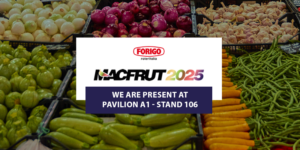News
Soil Hoeing: how to succeed in performing it best?
News _ 30 NOVEMBER _2023
When agrotechnics are directly identified with the reference crops, it means that they are fundamental: we are talking about soil hoeing and its crucial role for corn, sugar beet, soy, tobacco and many horticultural crops, called, not surprisingly, “crops”.
Specifically, soil hoeing involves mulching and mixing of soil surface in the inter-row, in order to obtain a series of benefits, such as:
- weeds control,
- water loss reduction for evaporation (worked soil layer interrupts the capillary rise of water,
- breakage of any surface crust,
- aeration/heating of the first centimeters of soil and greater permeability of the soil itself, which leads to the reduction of losses in the case of flowing irrigation.
What is soil hoeing and why is it useful?
On the basis of different cultural needs, the market offers a great variety of technical solutions. The available models are:
- fixed hoeing elements (elastic tines, ridging ploughshares),
- rotating elements (5-pointed wheels, discs)
- elements driven by the tractor’s PTO (rotary tillers/ inter-row power harrows).
Weeders with elastic tines are the most widespread solution on extensive crops. The number of working elements for each inter-row can usually vary from 2 to 5 and their disposition must allow working on the entire inter-row surface with a minimum gap between the elements, to reduce possible blockages.
The presence of oscillating bulkheads or discs on the sides of the cultivating element protects the crop and prevents soil from leaking out of the worked area. On corn, in plots particularly infested with weeds or for needs related to the irrigation technique, as an alternative to the elastic tines (or together with them) a couple of ridging plowshares can be placed to bring the soil back to the collar area of the plant.
The models with rotating elements exploit the rotation of idle tools caused by resistance with the ground. These tools are grouped in modules with horizontal or vertical axes and connected transversally to the frame by means of adjustable sections. The modules can be variously inclined (on the longitudinal and vertical axis) to modify the intensity of processing.
The main types of idle tools include star wheels or toothed profile discs. The former eradicate weeds from the ground thanks to their curve and forward speed, while the discs perform a cutting action which, in addition to devitalizing the weed, also allows light surface tillage of the soil.
The weeders with elements driven by the tractor’s power take-off carry out a mechanical action of crushing and aerating the soil through milling elements, which must be adjustable according to crop requirements. The characteristic of active tools is that of breaking up and disintegrating the soil both by impact against the protective casing and by reworking the rotor. The intensity of this process varies according to the adjustment of the rotation speed of the tools, which must be related to the feed rate.
This type of machine is more effective in those conditions in which the fixed tools are unable to effectively clean the inter-row, but their use must be managed carefully, especially in operating conditions which could lead to the formation of surface crust and processing sole.
The most advanced weeders make it possible to simultaneously work the land with other cultivation operations, such as fertilization and the distribution of plant protection products.
The importance of the right soil hoeing equipment
Hoeing machines are now available on the market equipped with pneumatic distribution systems and supply pipes capable of distributing different types of granular or liquid fertilizers (including sewage and digestate). Using technologies capable of varying the quantity of fertilizer distributed by exploiting the potential of the areas of the plot with high productivity, it also makes it possible to avoid overdoses in those areas capable of not optimizing the fertilization applied.
Regarding the defense, microgranulator kits allow the simultaneous distribution of microgranular plant protection products. In this case, a precise calibrating operation of the microgranulator according to the specific weight and granulometry of the product used is essential, so as to be able to guarantee a high uniformity of distribution of the product.
The traditional concept of weeder is evolving thanks to the growing diffusion of sensors and mechatronic systems: machines are available on the market which can discriminate, thanks to the use of optical sensors, the main crop and the weeds, modifying the trajectory of work of the operating machine, increasing the overall efficiency of the operation. Optically controlled precision weeders, already widespread on high-income horticultural crops, are, albeit slowly, gaining ground also in the field of industrial crops, such as beets or corn.
The new systems include electrically powered devices and the ability to work between plants as well as between rows. Moreover, from the point of view of precision agro-mechanics, these devices are usually driven by automatic systems in compliance with geographical maps which can send back processing data to the company.
Ensure efficient crops, at their maximum yield, with Forigo Roter Italia solutions dedicated to weeding the soil. We have been designing safe, high-performance tillage machines for over forty years. Take a look at our catalog or contact us: our team is at your complete disposal to answer all your questions and curiosities on the subject.

Research and Development Division of Forigo Roteritalia. Team of experts engaged in the study and analysis of the main agricultural and horticultural techniques used today. Knowledge combined with competence are the starting point for continuous improvement in a scenario of innovation and technological development.
Previous Exhibitions
30 MARCH 2025
Forigo at Agriumbria 2025: quality in soil preparation











